Antlion
| Antlions Temporal range: Early Cretaceous – Recent
| |
|---|---|

| |
| Distoleon tetragrammicus | |
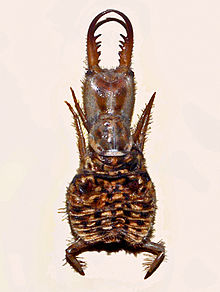
| |
| Distoleon tetragrammicus larva | |
| Scientific classification | |
| Domain: | Eukaryota |
| Kingdom: | Animalia |
| Phylum: | Arthropoda |
| Class: | Insecta |
| Order: | Neuroptera |
| Superfamily: | Myrmeleontoidea |
| Family: | Myrmeleontidae Latreille, 1802 |
| Subfamilies | |
|
see text | |
The antlions are a group of about 2,000 species of insect in the neuropteran family Myrmeleontidae. They are known for the predatory habits of their larvae, which mostly dig pits to trap passing ants or other prey. In North America, the larvae are sometimes referred to as doodlebugs because of the marks they leave in the sand. The adult insects are less well known due to their relatively short lifespans compared to the larvae. Adults, sometimes known as antlion lacewings, mostly fly at dusk or just after dark and may be mistakenly identified as dragonflies or damselflies.
Antlions have a worldwide distribution. The greatest diversity occurs in the tropics, but a few species are found in cold-
Antlions are poorly represented in the fossil record. Myrmeleontiformia is generally accepted to be a monophyletic group, and within the Myrmeleontoidea, the antlions' closest living relatives are thought to be the owlflies (Ascalaphidae). A 2019 study finds Myrmeleontidae to be monophyletic, aside from Stilbopteryginae and Palparinae, which form separate clades closer to Ascalaphidae.[1] The predatory actions of the larvae have attracted attention throughout history and antlions have been mentioned in literature since classical times.
Etymology
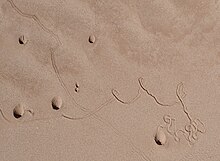
The exact meaning of the name "antlion" is uncertain. It has been thought to refer to ants forming a large percentage of the prey of the insect, the suffix "lion" merely suggesting "destroyer" or "hunter".[2] In any case, the term seems to go back to classical antiquity.[3] The antlion larva is often called a "doodlebug" in North America because of the odd winding, spiralling trails it leaves in the sand while relocating, which look as if someone has been doodling.[4]
The
Description


Antlions can be fairly small to very large neuropterans, with wingspans ranging from 2 to 15 cm (0.8 to 5.9 in). The African genus Palpares contains some of the largest examples. Acanthaclisis occitanica is the largest European species, with an 11 cm (4.3 in) wingspan, and most North American species approach this size.[4]
The adult has two pairs of long, narrow, multiveined, translucent
Males of most species have a unique structure, a bristle-bearing knob known as a "pilula axillaris", at the base of the rear wing. The abdomen in males is usually longer than in females and often has an extra lobe. The tip of the abdomen of females shows greater variation than that of males, depending perhaps on oviposition sites, and usually bears tufts of bristles for digging and a finger-like extension.[6]
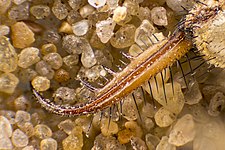
The antlion larva has a robust fusiform body, a very plump abdomen, and a thorax bearing three pairs of walking legs. The prothorax forms a slender mobile "neck" for the large, square, flattened head, which bears an enormous pair of sickle-like jaws with several sharp, hollow projections. The jaws are formed by the maxillae and mandibles; the mandibles each contain a deep groove over which the maxilla fits neatly, forming an enclosed canal for injecting venom to immobilise the victim,[7][8] and enzymes to digest its soft parts. The larva is clad in forward-pointing bristles which help it to anchor itself and exert greater traction, enabling it to subdue prey considerably larger than itself.[9]
Antlion larvae are unusual among insects in lacking an anus. All the metabolic waste generated during the larval stage is stored; some is used to spin the silk for the cocoon and the rest is eventually voided as meconium at the end of its pupal stage.[10]
Distribution
There are about 2,000 species of antlion found in most parts of the world, with the greatest diversity being in warmer areas. The best known species are those in which the larvae dig pits to trap their prey, but not all species do this. Antlions live in a range of usually dry habitats including open woodland floors,
Life-cycle
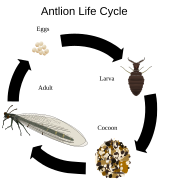
Apart from pit-trap-forming taxa, the biology of members of the family Myrmeleontidae, to which the antlions belong, has been little studied. The life-cycle begins with oviposition (egg-laying) in a suitable location. The female antlion repeatedly taps the prospective laying site with the tip of her abdomen and then inserts her ovipositor into the substrate and lays an egg.[12]
Depending on the species and where it lives, the larva either conceals itself under leaves, debris or pieces of wood, hides in a crack or digs a funnel-shaped pit in loose material.[7] As ambush predators, catching prey is risky because food arrives unpredictably and, for those species that make traps, maintaining one is costly. The larvae therefore have low metabolic rates and can survive for long periods without food.[13] They can take several years to complete their life-cycle; they mature faster with plentiful food, but can survive for many months without feeding.[14][15] In cooler climates they dig their way deeper and remain inactive during the winter.[10]

When the larva attains its maximum size, it
Ecology
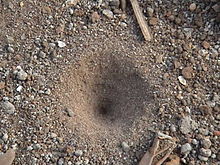
Antlion larvae eat small arthropods – mainly ants – while the adults of some species eat pollen and nectar, and others are predators of small arthropods.[17] In certain species of Myrmeleontidae, such as Dendroleon pantherinus, the larva, although resembling that of Myrmeleon structurally, makes no pitfall trap, but hides in detritus in a hole in a tree and seizes passing prey.[18] In Japan, Gatzara jezoensis larvae lurk on the surface of rocks for several years while awaiting prey; during this time they often become coated with lichen, and have been recorded at densities of up to 344 per square metre.[19]
The larva is a voracious predator. Within a few minutes of seizing its prey with its jaws and injecting it with

In trap-building species, an average-sized larva digs a pit about 2 in (5 cm) deep and 3 in (7.5 cm) wide at the edge. This behavior has also been observed in the
When the pit is completed, the larva settles down at the bottom, buried in the soil with only the jaws projecting above the surface, often in a wide-opened position on either side of the very tip of the cone.[23] The steep-sloped trap that guides prey into the larva's mouth while avoiding crater avalanches is one of the simplest and most efficient traps in the animal kingdom.[24] The fine grain lining ensures that the avalanches which carry prey are as large as possible.[22] Since the sides of the pit consist of loose sand at its angle of repose,[25] they afford an insecure foothold to any small insects that inadvertently venture over the edge, such as ants. Slipping to the bottom, the prey is immediately seized by the lurking antlion; if it attempts to scramble up the treacherous walls of the pit, it is speedily checked in its efforts and brought down by showers of loose sand which are thrown at it from below by the larva.[2] By throwing up loose sand from the bottom of the pit, the larva also undermines the sides of the pit, causing them to collapse and bring the prey with them. Thus, it does not matter whether the larva actually strikes the prey with the sand showers.[23]
Antlion larvae are capable of capturing and killing a variety of insects and other arthropods, and can even subdue small spiders. The projections in the jaws of the larva are hollow and through this, the larva sucks the fluids out of its victim. After the contents are consumed, the dry carcass is flicked out of the pit. The larva readies the pit once again by throwing out collapsed material from the center, steepening the pit walls to the angle of repose.[23]
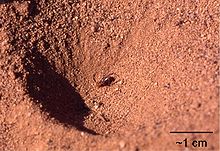
Antlion larvae require loose soil, not necessarily, but often, sand. Antlions can also handle larger granular material which is filtered out of the soil during pit construction.[22] The larvae prefer dry places protected from the rain. When it first hatches, the tiny larva specialises in very small insects, but as it grows larger, it constructs larger pits, and thus catches larger prey, sometimes much larger than itself.[23]
Other arthropods may make use of the antlion larva's ability to trap prey. The larva of the Australian horsefly (
Recent research has found that antlion larvae often "play dead" for a variable amount of time (from a few minutes up to an hour) when disturbed to hide from predators. The method is effective; it increased survival rates in patches that use it by 20%.[27] Furthermore, they appear to have maximized its usefulness—further increasing the duration is not likely to convey substantial survival benefits to the larvae.[28]
Evolution
The closest living relatives of antlions within the
| Neuroptera |
| ||||||||||||||||||||||||||||||
The
Taxonomy
The supra-generic classification within the Myrmeleontidae is disputed. Michel et.al recognise just four subfamilies,[31] with Brachynemurinae, Dendroleontinae and others placed in the Myrmeleontinae.
BioLib includes the following (with selected genera):
- Acanthaclisini Navas, 1912
- Brachynemurinae - 3 tribes:
- Brachynemurini Banks, 1927
- e.g. Brachynemurus Hagen, 1889 - Gnopholeontini Stange, 1994
- Lemolemini Stange, 1994
- Dendroleontinae (otherwise in Myrmeleontinae) - tribes:
- Acanthoplectrini Markl, 1954
- Bandidini Krivokhatsky, 1998
- Dendroleontini Banks, 1899
- Nuglerini Stange, 1976
- Periclystini Stange, 1976
- Voltorini Stange, 1976
- Myrmecaelurinae (otherwise in Myrmeleontinae) - tribes:
- Gepini Markl, 1954
- Isoleontini Holzel, 1969
- Myrmecaelurini Esben-Petersen, 1918
- Nesoleontini Markl, 1954
- MauliniMarkl, 1954
- Myrmeleontini Latreille, 1802
- Euroleon Esben-Petersen, 1918
- Hagenomyia Banks, 1911
- Myrmeleon Linnaeus, 1767
- others ...
- Porrerini Navas, 1913
- Porrerus Navás, 1913
- Nemoleontinae (otherwise in Myrmeleontinae) - tribes:
- Creoleontini Markl, 1954
- Delfimeini Krivokhatsky, 1998
- DistoleontiniTillyard, 1916
- GlenuriniBanks, 1927
- Gymnocnemini Navas, 1912
- Macronemurini Esben-Petersen, 1918
- Nemoleontini Banks, 1911
- Pseudoformycaleontini Holzel, 1987
- Palparinae (including Araripeneurinae)
- Dimarini Navas, 1914
- PalparidiiniMarkl, 1954
- Palparini Banks, 1911
- Palpares Rambur, 1842
- Pseudimarini Markl, 1954
- Aeropteryx Riek, 1968
- Stilbopteryx Newman, 1838
The following subfamilies have also been recognized by some taxonomists:[citation needed]
Antlions of uncertain systematic position are:
- †Palaeoleon (fossil)
- Newleon Miller & Stange, 2012
- †Samsonileon
-
Antlion larva trails (doodles) in sand
-
Thorax and head (with club-shaped antenna) of antlion adult
-
Larva
-
20x closeup of larva
-
Video of antlion larva trying to catch prey with sand traps and eating a small spider
-
Video of a larva trapping an ant by throwing sand at it

In culture and folklore
In popular folklore in the southern United States, people recite a poem or chant to make the antlion come out of its hole.[32] Similar practices have been recorded from Africa, the Caribbean, China and Australia.[33]
The
The French naturalist Jean-Henri Fabre wrote that "The Ant-lion makes a slanting funnel in the sand. Its victim, the Ant, slides down the slant and is then stoned, from the bottom of the funnel, by the hunter, who turns his neck into a catapult."[36][37]
Antlions appear as antagonists in the 1991
In the third book of
See also
- List of Myrmeleontidae genera
- Vermileonidae - wormlions
Notes
- ^ The verse runs "The old lion perisheth for lack of prey, and the stout lion's whelps are scattered abroad." (Authorised Version)
References
- S2CID 208581837.
- ^ . Vol. 2 (11th ed.). Cambridge University Press. p. 147.
- ^ a b Swanson, Mark (2007). ""Antlion" in the World's Languages". The Antlion Pit. Retrieved 23 February 2016.
- ^ a b c Swanson, Mark (2007). "What are Antlions?". The Antlion Pit. Retrieved 23 February 2016.
- ISBN 978-0-8061-3146-7.
- ^ Miller, Robert B.; Stange, Lionel A. (1 November 2015). "Glenurus gratus (Say) (Insecta: Neuroptera: Myrmeleontidae)". Featured Creatures. University of Florida. Retrieved 22 February 2016.
- ^ a b c Hawkeswood, Trevor J. (2006). "Effects of envenomation to a human finger and arm by the larva of an unidentified species of Myrmeleon (Neuroptera: Myrmeleontidae)" (PDF). Calodema. 7: 32–33. Archived from the original (PDF) on 2016-03-05.
- ISBN 978-0-226-56853-9.
- ^ a b Camp, Donya (2005). "Beneficials in the garden: Antlion". Galveston County Master Gardeners. Extension Horticulture at Texas A&M University. Retrieved 28 February 2016.
- ^ a b Swanson, Mark (2007). "Antlion Larvae Behavior: Discarding the Body". The Antlion Pit. Retrieved 24 February 2016.
- ^ Swanson, Mark (2007). "Where do Antlions Live?". The Antlion Pit. Retrieved 24 February 2016.
- ISBN 978-0-521-03729-7.
- ISBN 978-1-4020-6587-3.
- ^ New, T. (1991). Insects as Predators. NSW University Press. p. 69.
- ^ a b c Swanson, Mark (2012). "Reproductive Behavior". The Antlion Pit. Archived from the original on 4 March 2016. Retrieved 23 February 2016.
- ^ Swanson, Mark (2012). "Metamorphosis". The Antlion Pit. Retrieved 23 February 2016.
- ^ S2CID 49393365.
- ^ Devetak, Dušan; Podlesnik, Jan; Janževocič, Franc (2014). "Antlion Dendroleon pantherinus (Fabricius, 1787) (Neuroptera: Myrmeleontidae) in Slovenia". Acta Entomologica Slovenica. 18 (2): 159–162.
- ^ O'Neal, Matt. "Predatory insects" (PDF). MSU. Retrieved 23 February 2016.
- ISBN 978-3-662-43607-3.
- S2CID 36532488.
- ^ PMID 30900535.
- ^ a b c d Coelho, Joseph R. "The natural history and ecology of antlions (Neuroptera: Myrmeleontidae)". Retrieved 23 February 2016.
- PMID 16943491.
- ^ Botz, Jason T.; Loudon, Catherine; Barger, J. Bradley; Olafsen, Jeffrey S.; Steeples, Don W. (2003). "Effects of slope and particle size on ant locomotion: Implications for choice of substrate by antlions". Journal of the Kansas Entomological Society. 76 (3): 426–435.
- ISBN 978-1-4832-6370-0.
- ISSN 0362-4331. Retrieved 2021-03-08.
- PMID 33653098.
- ISBN 978-1-139-46776-6.
- PMID 25170303.
- ^ PMID 27780793.
- ISBN 0820328049.
- ISBN 978-0807138618.
- ^ ISBN 9781859843109.
- ISBN 9780415202046.
- ISBN 978-0-486-32011-3.
- ISBN 978-0-89875-711-8.
- ISBN 0-312-20958-4.
- ^ Moore, Chris. "You Don't Have To Go To A Galaxy Far, Far Away To See These 5 Real Life Star Wars Aliens!". Moviepilot.com. Archived from the original on 4 February 2017. Retrieved 4 February 2017.
- ISBN 978-0-14-030150-2.
External links
![]() Media related to Myrmeleontidae at Wikimedia Commons
Media related to Myrmeleontidae at Wikimedia Commons








